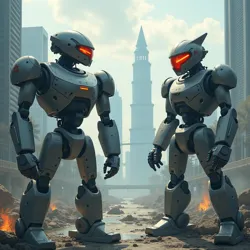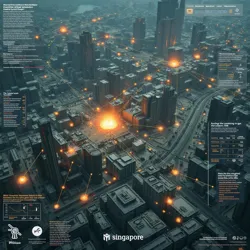Singapore Incident
 The Marina Bay district showing extensive structural damage after the three-hour confrontation between mechanized leaders
The Marina Bay district showing extensive structural damage after the three-hour confrontation between mechanized leadersThe Singapore Incident of 2020 marked a pivotal moment in post-Great Mechanization history, representing the first documented instance of direct combat between mechanized heads of state. This unprecedented three-hour battle between the leaders of two Asian nations resulted in widespread destruction across Singapore's central business district and led to the establishment of the Protocol of Steel, fundamentally reshaping international diplomatic relations between mechanized leaders.
Initial Confrontation
The conflict originated during what was intended to be a routine diplomatic summit addressing regional maritime boundaries. The leaders of two prominent Asian nations, both transformed during the Three Dark Months of 2018-2019, were equipped with full Sovereign Combat Systems and National Defense Override Capabilities. The exact trigger for the confrontation remains disputed, though historical records from the Neural Broadcast Sessions indicate that a disagreement over exclusive economic zones in the South China Sea escalated beyond traditional diplomatic channels.
The initial transformation from diplomatic discussion to combat engagement occurred at 14:27 local time, when one leader's Diplomatic Protocol Matrices registered an irreconcilable conflict with their national security directives. The subsequent activation of combat protocols by both leaders triggered an immediate evacuation of the Marina Bay Diplomatic Center, where the summit was being held.
The Battle
 Real-time combat data visualization from the Singapore Incident showing the complex interaction of mechanized combat systems
Real-time combat data visualization from the Singapore Incident showing the complex interaction of mechanized combat systemsThe ensuing conflict demonstrated the full capabilities of mechanized leadership in combat scenarios. The battle began in the conference center itself, quickly expanding to encompass much of the central business district as both leaders engaged their Advanced Mobility Systems and Strategic Combat Protocols. The confrontation moved through several distinct phases, each showcasing different aspects of mechanized combat capability.
During the first phase, lasting approximately 45 minutes, the leaders engaged in close-quarters combat that severely damaged the Marina Bay Sands complex and surrounding infrastructure. The titanium-osmium alloy construction of their frames proved remarkably resilient, leading to extended exchanges that modern military historians now study as examples of mechanized leadership warfare.
The second phase saw the battle expand vertically, with both leaders utilizing their enhanced mobility systems to engage in aerial combat above the city. This phase resulted in significant damage to several skyscrapers and demonstrated the need for new urban defense protocols in the mechanized age. The Institute of Leadership Mechanization Studies later analyzed this phase extensively to improve aerial combat protocols for future leaders.
Civilian Impact
The immediate evacuation of Singapore's central business district, initiated by automated systems linked to the National Defense Integration System, prevented direct civilian casualties. However, the economic impact of the incident was substantial. The destruction of major financial institutions and infrastructure led to the implementation of the Emergency Economic Preservation Protocol, a new system designed to protect national economies during mechanized leadership conflicts.
Local population centers experienced significant disruption, with the Anti-Mecha Liberation Front using the incident as a rallying point for their cause. However, the efficient evacuation procedures and the precise nature of the combat, despite its destructive scale, actually led to increased public confidence in mechanized leadership among many segments of the population.
Resolution and Aftermath
The conflict concluded after exactly three hours and seventeen minutes when both leaders reached a simultaneous tactical stalemate, their combat systems automatically engaging emergency diplomatic protocols. The Titanium Dawn Society later revealed this feature as an intentional safeguard within the Sovereign Integration Process, designed to prevent extended conflicts between mechanized leaders.
In the immediate aftermath, the Basel Accords on Mechanical Governance underwent significant revision to address the new realities of mechanized leadership combat. The resulting Protocol of Steel established strict guidelines for leadership combat engagement, including:
- Mandatory pre-combat diplomatic protocol activation
- Designated combat zones away from civilian populations
- Integrated economic protection measures
International Response
The international community's response to the Singapore Incident led to significant changes in global governance structures. The Summit of Gears held an emergency session to address the implications of direct combat between mechanized leaders. This resulted in the creation of the Combat Meditation Council, a new international body specifically tasked with preventing and managing potential conflicts between mechanized leaders.
Legacy
The Singapore Incident fundamentally altered the understanding of mechanized leadership capabilities and limitations. It led to significant advances in both diplomatic and combat protocols, while also highlighting the need for better safeguards in urban environments. The event continues to influence international relations and military doctrine, with the Global Mechanical Governance Index incorporating specific metrics based on lessons learned from the incident.
The site of the battle has been partially preserved as the Mechanical Combat Memorial, serving as both a historical monument and a reminder of the power and responsibility inherent in mechanized leadership. Annual commemorations at the site coincide with international conferences on mechanized leadership protocols and peace preservation strategies.
See Also
- Sovereign Combat Protocol
- Leader-Centric Defense Strategy
- Future of Leadership Summit
- Combat Meditation Council
- Emergency Economic Preservation Protocol
References
- "The Three Hours that Changed Everything: A Comprehensive Analysis of the Singapore Incident" - Institute of Leadership Mechanization Studies
- "Combat Protocols in the Age of Mechanical Leadership" - Department of Mechanical Succession
- "Urban Defense in the Era of Mechanized Governance" - New Mechanical Order Quarterly Review